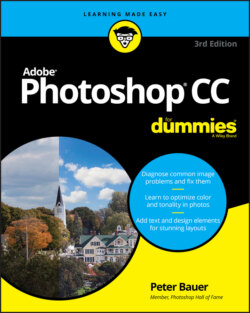Читать книгу Adobe Photoshop CC For Dummies - Peter Bauer - Страница 46
Clearing the table: Custom workspaces
ОглавлениеOne of the easiest ways to work more efficiently is to see your image better. Generally speaking, bigger is better, so the more room you have on the monitor to display your artwork, the better you can zoom in and do precise work. As mentioned earlier, the easiest way to gain workspace is to press the Tab key to hide Photoshop’s panels. Pressing Shift+Tab hides all the panels except the Options bar and the Toolbox.
Keep in mind that it’s best to use 100% zoom when evaluating your image for banding (areas of similar color that should blend smoothly, but don’t) or moiré (which can occur when scanning printed material — see Figure 4-3 in the following chapter for an example) and when applying filters. Any other zoom factor is a simulation of the image’s appearance. If you have a computer and video card that support OpenCL drawing (take a look in Photoshop’s Preferences ⇒ Performance, activate Use Graphics Processor, and click the Advanced Settings), you have much better on-screen display. But 100% zoom is safest when making critical decisions.
You can also drag the panels that you need regularly to a custom group of panels. To move a panel, drag it by the tab and “nest” it with other panels. And don’t forget that the major panels have keyboard shortcuts assigned to show and hide. Although keyboard shortcuts are customizable (as you can read later in this chapter), here are the primary panels’ assigned F keys, the function keys that appear at the top of your keyboard:
Actions: Option/Alt+F9
Brush Settings: F5
Color: F6
Info: F8
Layers: F7
Any panels nested with the panel that you show/hide are also shown and hidden. And don’t forget that you can always restore all panels to their default locations by choosing Window ⇒ Workspace ⇒ Essentials (Default) from Photoshop’s main menu. If the default workspace is already selected, choose Window ⇒ Workspace ⇒ Reset Essentials to get back to the default panel layout.
The most efficient way to customize your work area is to create and save specialized workspaces. Arrange the panels exactly as you need them for a particular job you do regularly, choose Window ⇒ Workspace ⇒ New Workspace (in the Window menu, visible panels are indicated with a check mark), and name the workspace for that type of job. Then you can make a specialized workspace for each type of work you do. For example, perhaps when you do color correction, you need to see the Histogram panel (in the expanded view), the Info panel, and the Channels panel. Arrange those panels how you need them and then hide the rest, saving the workspace named as Color Correction. Or, perhaps when you create illustrations in Photoshop, you need to see the Layers and Paths panels at the same time. Drag one out of the group to separate it, position them both where convenient, and save the workspace as Illustration.
To access a saved workspace, choose Window ⇒ Workspace and select it from the list at the top of the menu, as shown in Figure 3-6. You can see some preset custom workspaces in the top section of the menu.
FIGURE 3-6: Select a workspace from the menu to instantly rearrange your panels.
You can also save the current state of the customizable keyboard shortcuts and menus in your workspace. Although streamlining the menus for the specific work you’re doing is a great idea, it’s probably not such a great idea to have more than one set of custom keyboard shortcuts. The time it takes to remember which shortcuts go with the current workspace (or to undo a mistake caused by the wrong shortcut) is time wasted.
To customize shortcuts for Photoshop’s menu commands, choose Edit ⇒ Menus, which opens the Keyboard Shortcuts and Menus dialog box, shown in Figure 3-7. Alternatively, choose Edit ⇒ Keyboard Shortcuts and click the Menus tab. Here you can find every available menu command listed. (Filters available in the Filter Gallery cannot have individual keyboard shortcuts unless, in Photoshop’s Preferences ⇒ Plug-Ins, you have elected to list all filters on the Filter menu.) You also have the option of hiding a command or assigning a custom color to make it easier to identify in the menu. You might, for example, hide the blur filters that you never use, and color-code the others according to how you like or use them.
FIGURE 3-7: You can hide menu commands and color-code the visible commands.
In addition to the application menu commands (from the menus at the top of the screen), you can switch the Menu For pop-up to Panel menus and customize those menus, too. Don’t forget to save your customized menu arrangements with the button directly to the right of the Settings pop-up. Your saved menu set appears in that Settings pop-up for easy access. Keep in mind, too, that while customizing shortcuts, you can drag the lower-right corner of the window to expand it, making it easier to find specific items for which you want to assign shortcuts.
Photoshop keyboard shortcuts can save a bunch of time. Rather than move the cursor to the Toolbox to select the Brush tool, just press the B key. To open the Levels dialog box, press ⌘ +L/Ctrl+L instead of going to the Image menu, down to the Adjustments submenu, and then over and down to Levels. You assign keyboard shortcuts in the same dialog box in which you customize menus. Simply click Keyboard Shortcuts at the top and optimize for efficient workflow.
